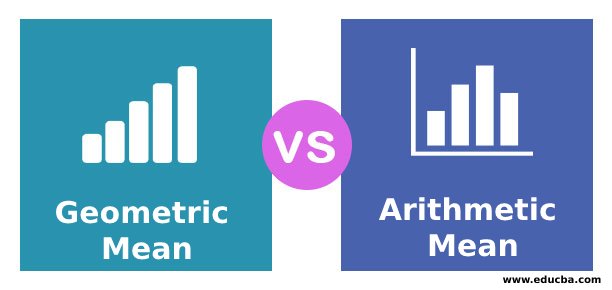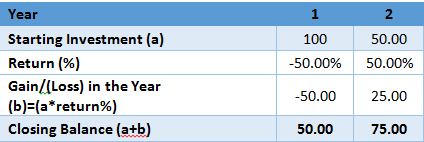Updated July 31, 2023

Difference Between Geometric Mean vs Arithmetic Mean
The Arithmetic Mean and Geometric Mean are the tools widely used to calculate the returns on investment for investment portfolios in the world of finance. People use the arithmetic mean to report higher returns, which is not the correct measure of calculating the return on investment. Since the return on investment for a portfolio over the years is dependent on returns in previous years, the Geometric mean is the correct way to calculate the return on investment for a specific time period. The arithmetic mean is suitable when variables used for the average calculation are independent.
Example: Suitability use of Geometric mean vs Arithmetic mean
1. Take an example of return on investment for $100 over 2 years. Suppose the returns in two years were -50% and +50% in the 1st and 2nd Average return calculation by using arithmetic mean will be 0% (Arithmetic mean = (-50%+50%) /2 = 0%)
This gives the wrong impression that the investor is breaking even on their investment and there is no loss or profit. However, a closer analysis gives an entirely different picture of the scenario.
The above table shows that the investment of $100 after -50% and +50% return in years 1 and 2 will be close to $75.Therefore, the investor is not breaking even on their investment as suggested by the arithmetic mean average, but he has incurred a loss of $25 after 2 years on its investment. This is well reflected by using Geometric mean to calculate the return on the investment over 2 years as below:
The geometric mean of returns
This means the annualized return on the portfolio had been negative at 13.40%. The investment position after two years is as below:
Therefore, the Geometric mean shows the true picture of investment: there is a loss in investment with an annualized negative return of -13.40%. Since the return in each year impacts the absolute return in the next year, a geometric mean is a better way to calculate the annualized return on investment.
2. When one needs to calculate the average of variables that are not dependent on each other, Arithmetic is a suitable tool to calculate the average. The average marks of a student for 5 subjects can be calculated by the arithmetic mean as the student’s scores in different subjects are independent of each other.
Head To Head Comparison Between Geometric Mean vs Arithmetic Mean (Infographics)
Below is the top 8 difference between Geometric Mean vs Arithmetic Mean:
Key Differences Between Geometric Mean vs Arithmetic Mean
Let us discuss some of the major differences between Geometric Mean vs Arithmetic Mean:
- Both Geometric Mean vs Arithmetic Mean are tools to calculate the returns on investment in finance and are also used in other applications such as economics and statistics.
- The arithmetic mean calculates by dividing the sum of the numbers by the number count. However, Geometric means take into account the compounding effect during the calculation.
- The geometric mean is the correct way to calculate the return on investment for a specific time period Since the returns on investment for a portfolio over the years are interdependent. However, the Arithmetic mean is better suited in the situation wherein variables used for calculation are not dependent on each other.
- When calculating the average of a data set where numbers are not skewed and are not dependent on each other, the arithmetic mean proves more useful and accurate. However, the geometric mean emerges as more effective and accurate when dealing with a data set characterized by a high level of volatility.
- The arithmetic mean is relatively easier to calculate and use than the Geometric mean, which is relatively complex.
- The geometric mean is widely used in finance, specifically in calculating portfolio returns. However, an Arithmetic mean is not an appropriate tool to use in return calculation.
- The Arithmetic mean of two numbers is always higher than the Geometric mean of the same numbers.
Geometric Mean vs Arithmetic Mean Comparison Table
Let’s look at the top 8 Comparison between Geometric Mean vs Arithmetic Mean
| The Basis Of Comparison |
Arithmetic Mean |
Geometric Mean |
| Definition | To find the arithmetic average of a series of numbers, you divide the sum of all the numbers by the total number count. | Geometric means take into account the compounding effect during the calculation period. It calculates by multiplying the numbers in a series and taking the nth root of the multiplication. Where n is the numbers count in series. |
| Formula | If there are two numbers, X and Y, in the series than
Arithmetic mean = (X+Y)/2 |
If there are two numbers, X and Y, in the series than
Geometric mean = (XY)^(1/2) |
| Suitability of Use | Arithmetic means shall be used in a situation wherein the variables are not dependent on each other and data sets are not varying extremely, such as calculating the average score of a student in all the subjects. | The geometric mean is suitable for calculating the mean when variables depend on each other, like when calculating the annualized return on investment over time. |
| Effect of Compounding | The arithmetic mean does not consider the impact of compounding, so it does not suit better to calculate the portfolio returns. | The geometric mean considers the compounding effect; therefore, it suits better for calculating the returns. |
| Accuracy | The arithmetic mean provides more accurate results when the data sets are not skewed and are not dependent on each other. | A geometric mean is more effective and accurate when the data set has a lot of volatility. |
| Application | People widely use the arithmetic mean in simple day-to-day calculations involving a more uniform data set. Economics and statistics frequently employ it. | The geometric mean is widely used in finance, specifically in calculating portfolio returns. |
| Ease of Use | The arithmetic mean is relatively easy to use compared to the Geometric mean. | The geometric mean is relatively more complex than the Arithmetic mean. |
| Mean for the same set of numbers | The arithmetic mean for two positive numbers is always higher than the Geometric mean. | The geometric mean for two positive numbers is always lower than the Arithmetic mean. |
Conclusion
Geometric Mean vs Arithmetic Mean finds their application in economics, finance, statistics, etc., according to suitability. The geometric mean is more suitable for calculating the mean and provides accurate results when dependent variables are widely skewed. However, an Arithmetic mean calculates the average when the variables are not interdependent. Therefore, these two should be used in a relevant context to get the best results.
Recommended Articles
This has been a guide to the top difference between Geometric Mean vs Arithmetic Mean. Here we also discuss the Geometric Mean vs Arithmetic Mean key differences with infographics and a comparison table. You may also have a look at the following articles to learn more.




